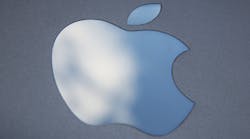Apple Developing New Mac Chip, Testing Its Dependence on Intel
Apple Inc. is designing a new chip for future Mac laptops that would take on more of the functionality currently handled by Intel Corp. processors, according to people familiar with the matter.
The chip, which went into development last year, is similar to one already used in the latest MacBook Pro to power the keyboard’s Touch Bar feature, the people said. The updated part, internally codenamed T310, would handle some of the computer’s low-power mode functionality, they said. The people asked not to be identified talking about private product development. It’s built using ARM Holdings Plc. technology and will work alongside an Intel processor.
Although Apple only accounted for 7.5% of worldwide computer shipments in the fourth quarter, according to data from IDC, the Mac line has long set the standard for design and component improvements. Its feature additions often start new technology trends that other manufacturers rush to follow. Apple and Intel declined to comment.
Apple’s first ARM-based Mac chip, known as T1, was introduced as part of the MacBook Pro update last October. This chip powers the Touch Bar--a screen built into the keyboard that lets users access app shortcuts, system settings and emojis--and some security features such as the enclave that stores payment and biometric data tied to the computer’s fingerprint reader.
Power Nap
Apple engineers are planning to offload the Mac’s low-power mode, a feature marketed as "Power Nap," to the next-generation ARM-based chip. This function allows Mac laptops to retrieve e-mails, install software updates, and synchronize calendar appointments with the display shut and not in use. The feature currently uses little battery life while run on the Intel chip, but the move to ARM would conserve even more power, according to one of the people.
The current ARM-based chip for Macs is independent from the computer’s other components, focusing on the Touch Bar’s functionality itself. The new version in development would go further by connecting to other parts of a Mac’s system, including storage and wireless components, in order to take on the additional responsibilities. Given that a low-power mode already exists, Apple may choose to not highlight the advancement, much like it has not marketed the significance of its current Mac chip, one of the people said.
Independence
The development of a more advanced Apple-designed chipset for use within Mac laptops is another step in the company’s long-term exploration of becoming independent of Intel for its Mac processors. Apple has used its own A-Series processors inside iPhones and iPads since 2010, and its chip business has become one of the Cupertino, California-based company’s most critical long-term investments.
Building its own chips allows Apple to more tightly integrate its hardware and software functions. It also, crucially, allows it more of a say in the cost of components for its devices. However, Apple has no near-term plans to completely abandon Intel chips for use in its laptops and desktops, the people said.
Intel’s designs and production technology have created processors that rivals and contract manufacturers haven’t been able match. If companies such as Taiwan Semiconductor Manufacturing Co. and Samsung Electronics Co. continue to narrow the gap with what Intel’s factories can make, Apple may have more scope to design its own parts. ARM-based processors dominate the smartphone and tablet markets in part because of their power-efficiency.
Apple started exploring a shift away from Intel processors five years ago partly to improve laptop power efficiency, Bloomberg News has reported. The new chip may first become available in an upgraded version of the MacBook Pro laptop planned for later this year, the people said. Apple is also working on a faster version of the 12-inch MacBook and a new iMac with multi-functional USB-C connectivity for this year, Bloomberg News reported in December.




